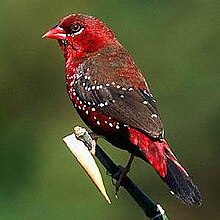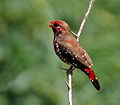ৰঙা টুনি
| ৰঙা টুনি | |
|---|---|

| |
| Male in breeding plumage | |
| সংৰক্ষণ স্থিতি | |
| জীৱবৈজ্ঞানিক শ্ৰেণীবিভাজন | |
| জগৎ/ৰাজ্য: | Animalia |
| পৰ্ব: | Chordata |
| শ্ৰেণী: | Aves |
| বৰ্গ: | Passeriformes |
| পৰিয়াল: | Estrildidae |
| গণ: | Amandava |
| প্ৰজাতি: | A. amandava |
| বৈজ্ঞানিক নাম | |
| Amandava amandava (Linnaeus, 1758) | |
| সমাৰ্থক | |
|
Estrilda amandava | |

ৰঙা টুনি (ইংৰাজী: Red Avadavat বা Red Munia, বৈজ্ঞানিক নাম-Amandava amandava) এবিধ সৰু আকাৰৰ চৰাইৰ প্ৰজাতি৷ ইয়াক সাধাৰণতে এছিয়াৰ মুকলি খেতি-পথাৰ বা ঘাঁহনি আদিত দেখা পোৱা যায়৷
বিৱৰণ[সম্পাদনা কৰক]
ৰঙা টুনি সৰু আকাৰৰ চৰাই৷ ইয়াৰ দেহটো ৰঙা বৰণৰ আৰু বগা ফুটুকীয়া৷ ইয়াৰ নেজডাল ক'লা আৰু ঠোঁটটো ৰঙা৷ প্ৰজনন কালত মতা ৰঙা টুনিৰ সমগ্ৰ দেহটো ৰঙা হৈ পৰে৷ কেৱল ইয়াৰ চকুৰ চাৰিওকাষে ক'লা বৰণৰ আঁচ থকা দেখা যায়৷ প্ৰজনন নোহোৱা কালত মতা চৰাইৰ ৰং শেঁতা পৰা হয়৷ মাইকীজনীৰ ৰং শেঁতা আৰু ডেউকাত বগা ফুটবোৰ মতাটোতকৈ কমকৈ থকা দেখা যায়৷ [2][3]
বিতৰণ[সম্পাদনা কৰক]
ৰঙা টুনিৰ মূল প্ৰজাতিটো বাংলাদেশ, ভাৰত, শ্ৰীলংকা, নেপাল আৰু পাকিস্তানত দেখা পোৱা যায়৷ তদুপৰি চীন, থাইলেণ্ড, ভিয়েটনামত ই বিস্তৃত হৈ আছে৷ ইয়াৰে আন দুটা উপ-প্ৰজাতি punicea আৰু decouxi. ক্ৰমান্বয়ে জাভা আৰু কম্বোডিয়াত দেখা পোৱা যায়৷[4][5][6][7]
বাসস্থান[সম্পাদনা কৰক]
ৰঙা টুনিয়ে প্ৰধানতঃ ঘাঁহনিৰে পূৰ্ণ সমতল অঞ্চল বা খেতি পথাৰৰ আশে পাশে চৰি ভাল পায়৷ [2]
আচৰণ[সম্পাদনা কৰক]
ৰঙা টুনিক সাধাৰণতে সৰু সৰু গোটত চৰা দেখিবলৈ পোৱা যায়৷ [8] ই খুউব চুটি আৰু খৰকৈ 'চ্চিইইপ'' ধৰণে মতা শুনা যায়৷ [9]
খাদ্য[সম্পাদনা কৰক]
ৰঙা টুনিয়ে ঘাঁহৰ গুটি, পোক-পৰুৱা আদি খাই জীয়াই থাকে৷[10]
প্ৰজনন[সম্পাদনা কৰক]
এই চৰাইবিধে প্ৰজনন কালত যোৰা পাতে৷[11] যোৰাৰ ইটোৱে সিটোৰ পাখি পৰিষ্কাৰ (preen) কৰি দিয়ে৷ [12] ইহঁতে ঘাঁহ পাতেৰে বাহ সাজে৷ এবাৰত ৫-৬ টাকৈ বগা বৰণৰ কণী পাৰে৷ [13]
আলোকচিত্ৰৰ ভঁৰাল[সম্পাদনা কৰক]
তথ্যসূত্ৰ[সম্পাদনা কৰক]
- ↑ BirdLife International (2012). "Amandava amandava". IUCN Red List of Threatened Species. Version 2012.1. International Union for Conservation of Nature. http://www.iucnredlist.org/apps/redlist/details/106008663। আহৰণ কৰা হৈছে: 16 July 2012.
- ↑ 2.0 2.1 Rasmussen PC & JC Anderton (2005). Birds of South Asia: The Ripley Guide. Volume 2. Smithsonian Institution & Lynx Edicions. পৃষ্ঠা. 572.
- ↑ Whistler, Hugh (1949). Popular Handbook of Indian Birds. Gurney and Jackson. পৃষ্ঠা. 216–217. http://www.archive.org/stream/popularhandbooko033226mbp#page/n259/mode/1up.
- ↑ Oates, EW (1890). Fauna of British India. Birds. Volume 2. Taylor and Francis, London. পৃষ্ঠা. 192–193. http://www.archive.org/stream/faunaofbritishin02oate#page/192/mode/1up/search/amandava.
- ↑ Deignan, HG (1963). "Checklist of the birds of Thailand". National Museum Bulletin খণ্ড 226: 216. http://www.archive.org/stream/bulletinunitedst2261963unit#page/216/mode/1up/search/amandava.
- ↑ Paynter RA (Ed) (1968). Check-list of the birds of the world. 14. Museum of Comparative Zoology. পৃষ্ঠা. 348–349. http://www.archive.org/stream/checklistofbirds141968pete#page/348/mode/1up.
- ↑ Baker ECS (1926). Fauna of British India. Birds. Volume 3 (2 সম্পাদনা). Taylor and Francis. পৃষ্ঠা. 95–97. http://www.archive.org/stream/BakerFbiBirds3/BakerFBI3#page/n116/mode/1up/.
- ↑ Evans, SM (1970). "Some factors affecting the flock behaviour of red avadavats (Amandava amandava) with particular reference to clumping". Animal Behaviour খণ্ড 18 (4): 762–767. doi:10.1016/0003-3472(70)90025-4.
- ↑ Ali S & SD Ripley (1999). Handbook of the birds of India and Pakistan. 10 (2 সম্পাদনা). Oxford University Press. পৃষ্ঠা. 106–108.
- ↑ Inglis, CM (1910). "Note on the Spotted Munia (Uroloncha punctulata) and the Indian Red Munia (Sporaeginthus amandava)". J. Bombay Nat. Hist. Soc. খণ্ড 20 (2): 517–518.
- ↑ Sparks, JH (1964). "Flock structure of the Red Avadavat with particular references to clumping and allopreening". J. Anim. Behaviour খণ্ড 12: 125–126. doi:10.1016/0003-3472(64)90113-7.
- ↑ Sparks, John H. (1965). "On the role of allopreening invitation behaviour in reducing aggression among red avadavats, with comments on its evolution in the Spermestidae". Journal of Zoology খণ্ড 145 (3): 387. doi:10.1111/j.1469-7998.1965.tb02024.x.
- ↑ Hume, AO (1890). The nests and eggs of Indian Birds. 2. R H Porter, London. পৃষ্ঠা. 147–149. http://www.archive.org/stream/nestseggsofindia02humerich#page/147/mode/1up/search/amandava.
বাহ্যিক সংযোগ[সম্পাদনা কৰক]
| ৱিকিমিডিয়া কমন্সত Amandava amandava সম্পৰ্কীয় মিডিয়া ফাইল আছে। |
| ৱিকিপ্ৰজাতিত Amandava amandava সম্পৰ্কে অধিক তথ্য আছে |






